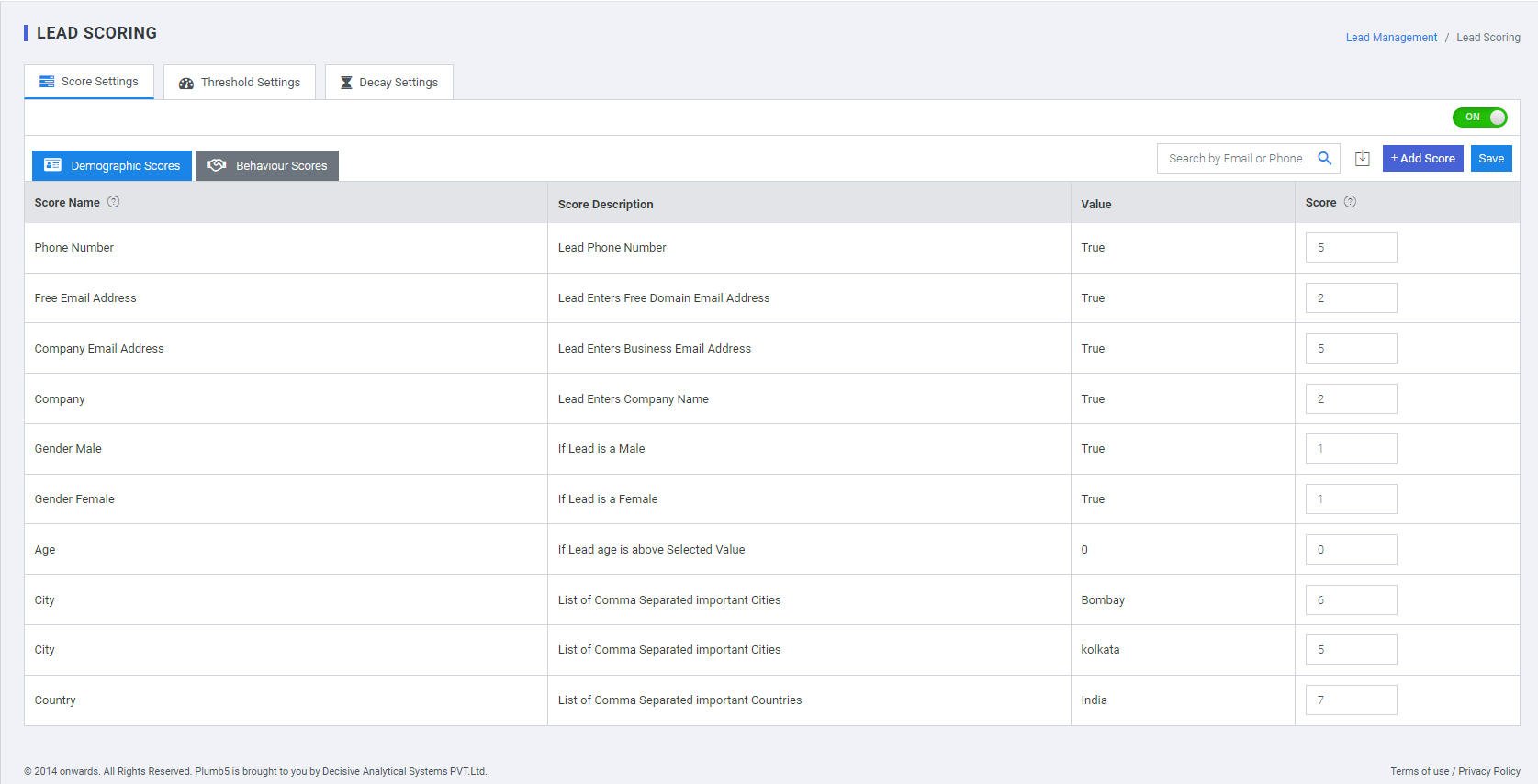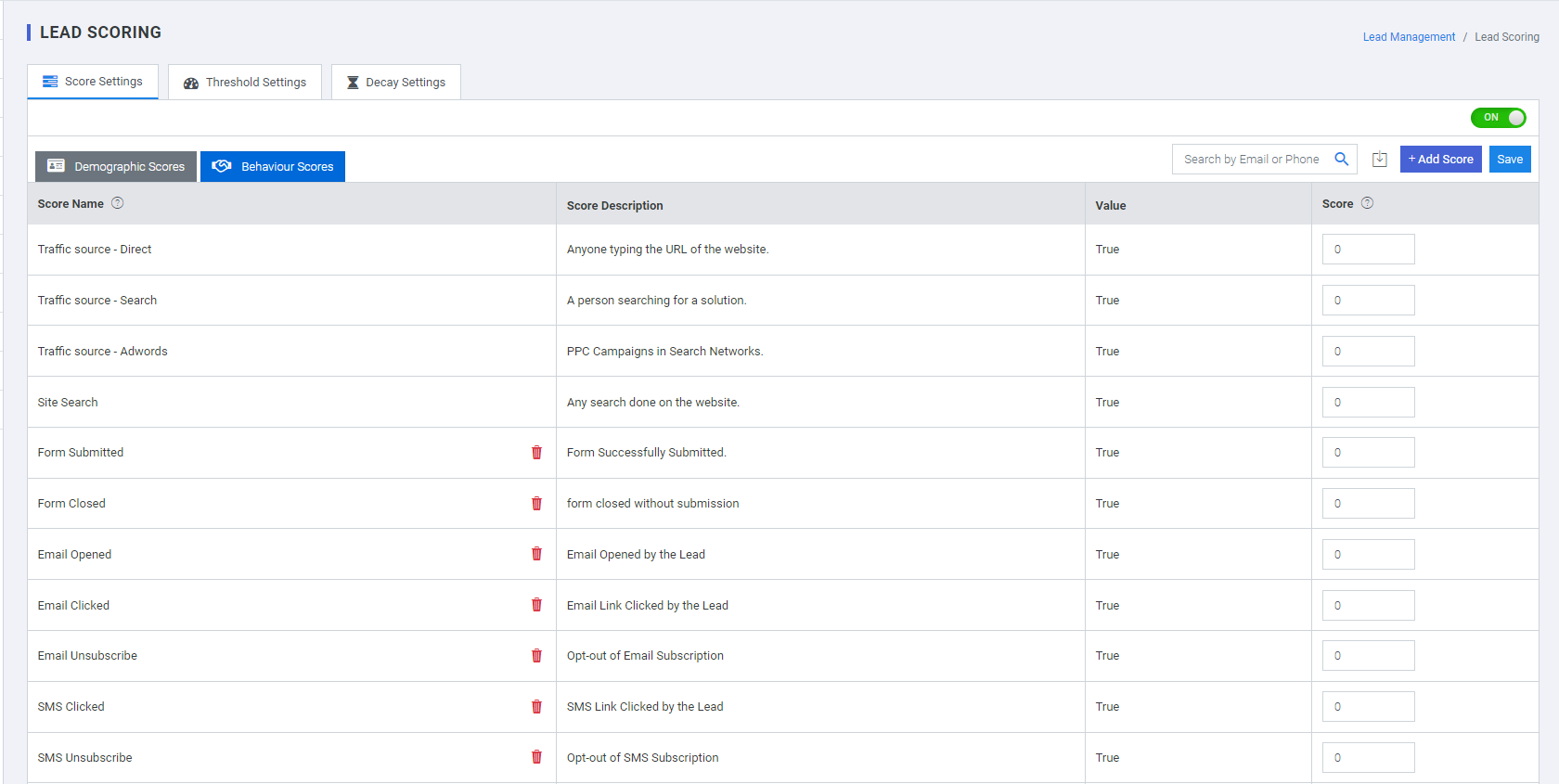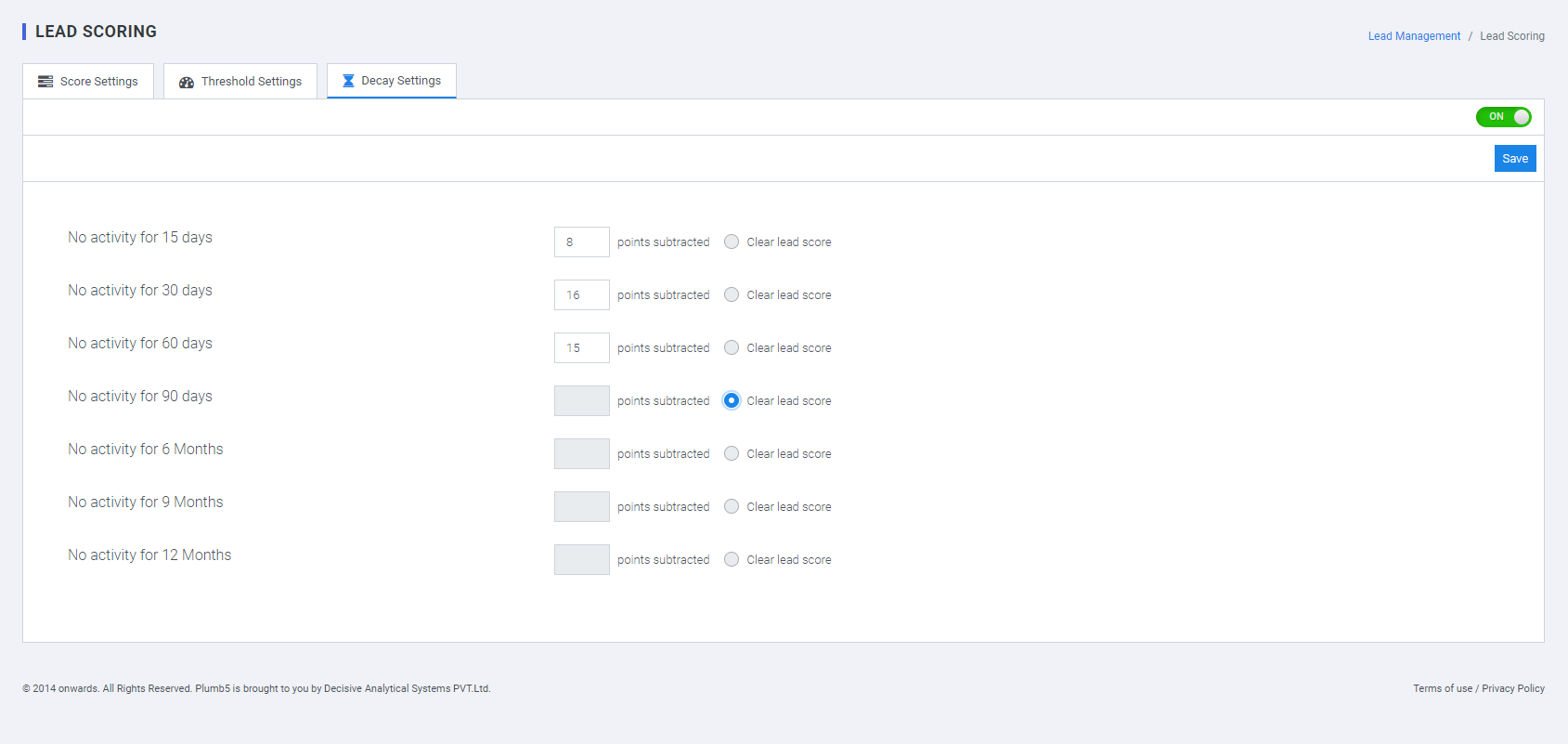Lead Scoring
What is lead scoring?
Lead scoring is a strategy that marketing and sales teams use to identify which prospects are most valuable to a company in their current sales funnel.
Plumb5 lead scoring system assigns point values to leads based on different attributes, such as demographics data that matches an ideal customer profile, or actions a prospective customer takes during the buyer journey, such as website visits, content downloads or email clicks. The point-based lead scoring model assigns a threshold for leads to reach, and when they reach that point total, they qualify as hot leads for the sales team. Knowing when to reach out to a prospect makes sales teams more focused, informed and productive when engaging with prospects.
The Scoring section is divided into 3 parts namely:
- Score Settings : Use this Module to set demographic & behavioural scores for the leads.
- Threshold Settings : Use this module to set the threshold value for a score before an action needs to be taken.
- Decay Settings : Use this module to execute Score degradation or decay based on Time elapsed..
Longstanding customers or prospects that frequently engage with a brand are more open to individualized attention from a sales representative rather than someone engaging with a brand for the first time. Lead scoring enables teams to focus their efforts on consumers who have already reached a certain step in the sales journey, such as downloading a case study or requesting a quote, and bring that prospect closer to completing a purchase.
Score Settings
Demographic Scores
Demographic scoring is based on characteristics the lead possesses and is often submitted by the lead itself. Demographic score helps measure how well you’re targeting your marketing. For example, certain channels might generate leads that are consistently under-qualified, something that you need to act on.
The Demographic lead scoring model involves identifying specific profile criteria that correlates to the best representation of your ideal customer. Some examples of demographic criteria to score on may include:
- Phone Number
- Free Email Address
- Company Email Address
- Company Name
- Gender Male
- Gender Female
- Age
- City
- Country

Behaviour Scores
Behavioral scoring is scoring based on the actions the lead takes, both online and offline, and is often observed by your marketing department. Behaviour score helps measure a prospect’s level of sales readiness and provides a sense of which channels provide the best prospects.
The Behaviour lead scoring model involves identifying various sales-ready behaviours and actions, and associating point values when completed. Certain behaviours that should be associated with score values may include:
- Opening emails
- Clicking on links
- Visiting specific web pages/landing pages
As these values continue to aggregate and grow, a lead becomes more familiar with the various products and services as they move through the research phase of their buyer’s journey. Once they reach the optimum threshold for their behaviour score (i.e. 40 points), sales can then be alerted and should be ready to reach out.

By understanding who the ideal customer is based on their profile traits, a marketer can further ensure that they are developing the appropriate content for their targeted personas. By combining both behaviour and demographic scoring, marketing qualified leads will not only be easier to identify, but will also generate more ROI! At Plumb5, we specialize in building a successful lead scoring model tailored to your business and strategy.
Threshold Settings
A Lead Score Threshold refers to the point value at which the prospect is considered to be Sales-ready. Whenever the Lead Score reaches or exceeds this threshold value, it becomes a Marketing Qualified Lead (MQL) and is further passed on to Sales for them to finalize a deal. It is, however, essential to get the threshold value right. If it is too low and leads are qualified prematurely, the process for Sales will become much more complex since the Leads are not ready to be pursued yet. But if the value is too high, there is a high chance of losing the lead to a competitor since Sales took too long to respond.
Thresholds are synonymous with the lifecycle stages of your sales process. Contacts will move “up” or “down” between stages based on their actions.
Some of the standard stages of the sales process:
- Prospect – potential contacts
- Lead – more engaged leads
- MQL (Marketing Qualified Lead) – The most engaged leads and the contacts your marketing team should be creating opportunities to get them to Sales. Basically, Marketing does this by giving these leads something to interact with that proves their level of interest and engagement.
- SQL (Sales Qualified Lead) – the primary target for the sales team. Sales should spend the majority of their time on contacts identified as SQLs.

Decay Settings
Lead Decay Rate helps businesses take into account stagnant Leads and take suitable actions for them. Ideally, if a Lead hasn’t interacted with the brand over a significant period of time, it would make sense to lower its Lead Score. For example, businesses usually lower a Lead Score if the Lead stopped opening their Promotional emails or downloaded a piece of content but never interacted with the website again.
Point decay is an important part of your Lead Scoring framework because if your contacts don’t stay engaged, they’re no longer hot leads after a certain point. Their scores should decrease in value over time to reflect that. You determine point decay when you create your Lead Score Rules and set a time for each rule’s points to expire:
Score Degradation helps businesses pick out poor Low-intent Leads and focus on more valuable, High-quality Leads, just like the Negative Lead Score. To leverage Score Degradation, businesses need to understand which actions should warrant point degradations. A common strategy that numerous businesses implement is reversing the point system they use for Implicit Scoring. For example, if a Lead is given 10 points for subscribing to a Newsletter, they lose 10 points for unsubscribing.

Lead scoring best practices
When defining the lead scoring model, every company has a different approach or scoring process. The best way to come up with a lead scoring strategy is to look at data from past leads to create a value system. This historical data helps pinpoint which leads have more compatibility with a company's product based on their assigned values.
Here are some best practices to help teams reach more qualified leads and higher sales revenue.
-
Align Sales and Marketing
One of the first steps for rolling out a lead scoring model is to align the sales and marketing teams. Over time, sales teams begin to identify trends in conversations that turn into opportunities for the pipeline. These trends include who the decision-makers are, what problems they are attempting to solve and what pain points prospects have. From these conversations, sales teams are much closer to the leads than marketing teams.
Marketing teams can work with sales to determine which demographics yield positive point assignment and show which content those qualified leads were interested in. Marketing teams can begin to develop a scoring model with this information that incorporates historical patterns to the buyers.

Tip 1: Separate your direct MQL qualifiers into Groups -
Define Buyer Persona and profiles
Developing detailed personas and customer profiles enables marketing teams to flag leads that match that description. Buyer personas are detailed, but fictional, representations of a company's target audience. Sales and marketing teams apply scores to the target audience, as well as additional scores when those prospects begin engaging with campaigns or content that is tailored for that group, which validates that this is a hot lead for the sales team. Assigning scores based on demographic data is key to identifying marketing qualified leads (MQLs). Some examples of buyer persona and customer profile data to score against include the following:
- Title / Role
- Department
- Industry
- Company, if a company is looking to target specific companies with account-based marketing (ABM) campaigns
- Annual Revenue
- Location, including state, region or country
-
Determine a lead scoring threshold
Lead scoring aims to develop sales-ready leads or MQLs. When target customers become MQLs -- based on demographic data or previous actions -- that means they have hit the lead scoring threshold.
The lead scoring threshold can be an arbitrary number, but it may be best to start with an MQL score of 100. Each activity can be weighted appropriately. After nurturing those leads and when their cumulative score equals 100, an internal workflow triggers to notify sales teams that this lead is a sales-ready MQL.
Here is an example of lead scoring points distribution toward a threshold. Lead scoring models and points assignment vary by individual teams.
Lead A
- 15 points: fills out a form on a landing page;
- 5 points: clicks on last three emails; and
- 30 points: matches the company's ideal buyer persona demographics.
Lead A receives a score of 50 and requires additional nurturing to meet the score threshold of 100.
Lead B
- 15 points: registers for a webinar;
- 5 points: attends that webinar;
- 5 points: visits the website's homepage; and
- 5 points: clicks on a blog post.
Lead B receives a score of 30 points. If Lead B requests a demo after these engagements, they receive 100 points because that is an immediate MQL action.
Lead B's cumulative score of 130 goes over the threshold, and the CRM system notifies sales that this prospect is a hot lead that it should prioritize. Meanwhile, marketers continue to nurture Lead A.

Tip 2: Keep your score ranges small
-
Assign positive scores for customer actions
Now that the company established a lead threshold and certain persona demographics give points toward the overall score, assigning points based on online behaviour will help push those prospects closer to their MQL designation. The previous example shows how customer actions receive points. These actions can include the following:
- frequent visits to a website over a time period;
- multiple content downloads or event registrations;
- visits to a pricing page;
- opened emails;
- contact form submissions or requests for a demo or free trial;
- blog views;
- call-to-action clicks;
- social media account follows; and
- clicks on paid ads.

Tip 3: Assign your score range to different iterations of the action
-
Determine point decay
The less engagement leads have with the brand, the more it illustrates they may not be interested in a company's products or services. In contrast, leads that engage frequently are likely to become MQLs. If a lead doesn't visit the website as frequently anymore, doesn't open email communications or doesn't act on any active campaigns, points should begin to drop off. While every company's points decay model varies, a good rule of thumb is to subtract points over time:
- After 30 days of no action, reduce 10 points.
- After 60 days of no action, reduce 25 points.
- After 90 days of no action, reduce 50 points.

Tip 4: Make your maximum score the addition of all your scores
-
Track MQL conversion rates
In order to determine if a lead scoring model is successful or not, sales and marketing teams need to look at the MQL conversion rates. The MQL conversion rates refer to how many of the MQLs are turning into sales qualified leads (SQLs) or opportunities. The output of this evaluation may require a marketing team to rework its lead scoring model.
Measuring the percentage of MQLs that turn into SQLs gives teams an idea of the quality or readiness of these leads going through the lead scoring model. If one out of every 20 MQLs turns into an SQL, the sales and marketing teams may be qualifying leads too soon, and they need to adjust the points threshold or score assignments.
-
Revisit lead scoring models frequently
If qualified leads aren't turning into opportunities or a marketing team is constantly adding on new campaigns that require their own scoring model, sales and marketing teams should schedule regular check-ins to evaluate the performance of the existing model.
Holding a meeting between the sales and marketing teams once a quarter gives the opportunity to discuss if the lead scoring mechanism works, where there is room for improvement or what scores they need to adjust based on performance.

Tip 5: Segment your maximum range into 3 parts